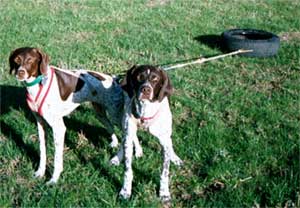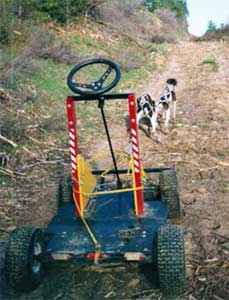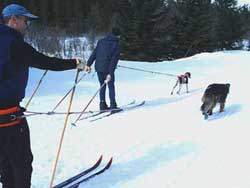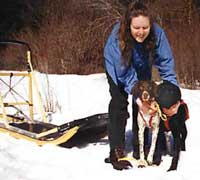"My
hyperactive dog is driving me crazy!!!"
Congratulations-
you've come to the right place!

"Hyperactivity" and related energetic behavior is apparently one of the leading reasons why dog owners surrender dogs to shelters.
It is NORMAL for some dogs to need more than a long walk every day. But you have to work to pay for that kibble and kennel somehow. Teaching a dog to pull in harness has been the best solution for us- they get plenty of hard, fun exercise in a reasonable amount of time.
The good news is that if your dog is healthy and energetic, this might be the easiest thing you'll ever have the pleasure of training them to do. Even non- northern breeds (such as my GSPs) usually take to it very quickly.
Below is a collection of ideas and links to places to find more information. THIS PAGE IS BY NO MEANS COMPREHENSIVE- it's purpose is to help some dogs and owners live together a little better. Covered here is tire pulling, scootering, carting, skijoring, and sledding.
GETTING
STARTED
Again, there are MANY considerations to working a dog in harness that won't be mentioned here- we're just hitting the high spots.
- It's always a good idea to talk to your vet before embarking on harness training, especially if your dog is older, younger, overweight, has had a medical condition, etc.
- Don't do these activities in warm weather. Dogs overheat easily with very bad results.
- Watch the feet- avoid running on pavement and lay off if their pads look worn. Cheap and effective boots are available from mushing outfitters.
- Get a good mushing harness that fits. See Sleddogcentral for links to outfitters- they'll help you.
- Keep it all positive- remember, it's fun!
 TIRE PULLING
TIRE PULLING
One small recycled car tire + 6 feet of rope + 1 or 2 dogs... simple! This is the best place to start, even if you have other goals for your dog in harness, as you can teach them to pull as well as directional commands easily.
If you're trying to get a dog in shape for any athletic competition, the muscle that they build when pulling hard like this can help prevent injuries.
However, it's also just a great way for your dog to get extra exercise when you're out for a walk. 5 minutes on the tire is PLENTY to start with.
 SCOOTERING
SCOOTERING
One or two dogs can easily pull you on a scooter at a dead run... the trick is to stay in control. :) I like to wear gloves, a helmet, eyeglasses, and insulated overalls in case I fall. Scooters are MUCH safer than hooking a dog to a bicycle.
Dog scooter races have long been popular in Australia and New Zealand, and has been catching on fast in Europe.
Small scooters can easily be thrown in a car; larger ones may require a bike rack. I like taking mine with us when we travel so I can keep the dogs in a little more manageable state.
MORE INFORMATION: http://www.dogscooter.com/ has great pictures, links, and is run by Daphne- probably the most supportive dog person you'll ever meet.
 CARTING
CARTING
Carts offer more control than scooters- especially once you go over 2 dogs- but are substantially more expensive and heavy. New models have been developed that fold down for easier transport. Mushers and some hunters will take this idea one step further and hook up dogs to an ATV to condition them.
Cart races and fun runs are very common in regions where snow is intermittent.
The cart in this picture is a #130 Sand Lynx, and the dogs can haul it up almost anything. They've also carried groceries and dog food home with it.
MORE INFORMATION: www.harborside.com/~toffssandlynx is Jim Tofflemire's site for the Sand Lynx (FYI, I made the site but I don't get any money for it). Sleddogcentral is also a great place to find other folks with dogs dragging wheeled rigs around.
 SKIJORING
SKIJORING
Strap on cross country skis, hook to 1 to 3 dogs using a skijoring harness around your waist (some folks also use a climbing harness), and go in the snow! This sport was started in Scandinavia over 60 years ago and is becoming very popular both for racing and recreation.
This is a great winter workout for both you and the dog, as you can continue striding and poling while the dog pulls.
Make sure you have SOME skills with the skis before hooking to the dog, and use a longer line if you need it- we don't want dogs getting hit with skis.
MORE INFORMATION: http://www.skijornow.com/ is a great place to get started.
 SLEDDING
SLEDDING
Contrary to popular myth, your dogs don't have to look like something from a Jack London tale to work quite nicely in front of a sled.
Sleds offer better braking than skis, and since most modern sleds have easily changed plastic runners you can take them in areas where the snow is getting too thin for skis... IF you have sufficient control over your team.
These two dogs gladly hauled in camping gear a mile or two for an overnight stay at a state park one snowy April. We had the whole place to ourselves- and the fee box wasn't even installed yet!
MORE INFORMATION: http://www.adanacsleds.com/ has a beginner's sled that is shipped partially disassembled via UPS... a very good bargain for someone starting out. Sleddogcentral has classifieds listing used sleds as well as articles, etc.
For more great ideas on things to do with your dog, see http://www.dogplay.com/.
Rogan and Dulcie would like to add that while they like the occasional treat, they really are much more excited when the harnesses come out than when the food dishes are put on the floor. They also find it much easier to be obedient after a 5 or 10 mile run, and they'd like to see other dogs have the same chance to be "good" for a change. :)